|
Actually, this started out as "Why does Peter Pan have pointed ears?" That was fairly easy. It was Disney’s creative choice to depict him that way. The pointed ears, a trait shared with the fairy Tinker Bell, emphasized the character’s magical and otherworldly nature. The two also wear green – a color traditionally given to fairy clothing. Any other sources showing Peter Pan with pointed ears seem clearly drawn from Disney. So . . . pointy ears are a marker of an otherworldly nature, common to elves and fairies. When did that happen? Here, elves and fairies are basically synonymous, as in Shakespeare. A lot of sources automatically point to Tolkien as the one who popularized the pointy-eared elf; however, Tolkien never described his elves in-depth. In fact, in the fandom, opinions are divided on whether his elves’ ears are really intended to be pointy at all. In some of his letters, he did say that their ears were “leaf-shaped” and that a hobbit’s ears were "ears only slightly pointed and 'elvish'" (Letters, 35 (27), Annotated Hobbit, 10); however, in that second case, it's possible he was referring not to his elves but to the little Santa-style elves of contemporary imagination, who already had pointy ears. Either way, Tolkien was by no means the first or most famous user of pointy-eared elves. So then where does the trend really begin? As far as I can tell, it starts with satyrs. There were many animal-human hybrid monsters in Greek and Roman myth. Silenus, part man and part donkey, was depicted with a donkey's pointed ears. Satyrs had goats' ears and legs. Later, as Christianity rose to power, these kinds of magical creatures were demonized, and pointed ears and hooves became the attributes of the devil. And fairies were also at odds with Christianity. Creatures who could be frightened away with holy symbols or the sound of church bells. I think the most important bridge here is none other than Robin Goodfellow, or Puck. Puck was a fairy being, but often the line between Puck and Devil was blurred. An early woodcut from Robin Goodfellow: His Mad Pranks and Merry Jests (1629) shows Puck as a faun, resembling the gods Pan and Priapus. Looking at Puck's donkey ears here, it’s easy to see how they could develop over the years into Tinker Bell’s ears. (Incidentally, Peter Pan does have similarities with the god Pan. The name, for one. And the panpipes.) See also Peter Paul Rubens's 1616 version of Silenus and the Satyrs here. In 1789, a more innocent and childlike Puck appeared in a painting by Joshua Reynolds. The goat legs are gone, but the pointy ears remain. A Midsummer Night's Dream is the source for a lot of fairy paintings. Joseph Noel Paton painted a few - one, in 1849, was the Quarrel of Oberon and Titania. It's a huge and detailed scene, showing many wildly varied fairies. Some have little butterfly wings. Oberon and Titania appear human in shape, but godlike. Of their smaller subjects, some bear butterfly wings, and I think at least one has pointed ears. This kind of variety in size and appearance is par for the course in this era. Still, in folklore and fairytales, there aren't many mentions of fairy ears. You'll get dwarves with long beards or ladies of extraordinary beauty or trolls with huge noses, but ears are rare. When they do show up, they are not quite the delicate pointed ears of Tinker Bell. In A Peep at the Pixies, or Legends of the West by Anna Eliza Bray [1854], the fairy called Pixy Gathon is described with “very large ears, hairy and long, resembling those of a donkey.” He also has a tail. This is pretty close to Puck and Pan. Back to the Greeks for a moment. The sculpture of the Resting Satyr was attributed to Praxiteles, who lived in the 4th century BC. The nude figure appears entirely human except for its pointed, goat-like ears. Why do I bring this up? Because it might shed some light on why fairies are shown with pointed ears. 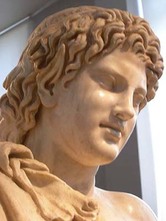 In 1860, Nathaniel Hawthorne based his work The Marble Faun on this sculpture and described it thus: "These are the two ears of the Faun, which are leaf shaped, terminating in little peaks, like those of some species of animals. Though not so seen in the marble, they are probably to be considered as clothed in fine, downy fur. . . . The pointed and furry ears . . . are the sole indications of his wild, forest nature." So the inhuman ears are the main clue to the beautiful creature’s true, otherworldly nature. Hawthorne's book seems to have been pretty well-known at the time. Perhaps this lent itself to a growing trend of oddly-eared creations. During the Victorian era, fairies become a popular subject in art. Some fairy artists in the 1800s were John Anster Fitzgerald, Richard Dadd, and Richard Doyle. However, there seem to be classes of fairies. There are the tall, humanoid fairies with flowing hair, like Oberon and Titania. Then there are the Pucks, the tiny, grotesque and pointy-eared gnomes. Pointed ears are an attribute of more wild and inhuman creatures - ranging from comically grotesque to monstrous. Check out Dadd's "The Fairy Feller's Master Stroke." 1882 - Walter Crane's illustration of The Elves and the Shoemaker by the Brothers Grimm. Later editions will also have pointy-eared elves - like the 1911 translation with illustrations by Charles Folkard. 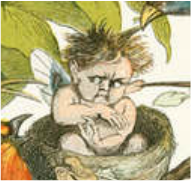 1884: Andrew Lang’s Princess Nobody with illustrations by Richard Doyle. Some of the fairy creatures bear ears that are large and elongated , but not exactly pointy. In English Fairy Tales, by Joseph Jacobs, published in 1890, there are two mentions of pointy-eared fairies. In "Fairy Ointment," some fairies are apparently human-sized and very beautiful, with clothing of "white silk" or "silvery gauze." However, the smaller fairies or pixies are “flat-nosed imps with pointed ears" and "long and hairy paws.” In "The Cauld Lad of Hylton," a brownie is described as “half man, half goblin, with pointed ears and hairy hide.” In both cases, the pointy ears come with a hairy appearance, increasing the similarity to a wild beast. 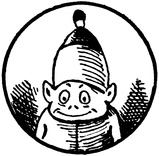 1899: The first comic strip of The Brownies by Palmer Cox is published. This series, which stars small, pudgy brownies with slightly pointed ears, becomes incredibly popular and even gets a camera named after it. 1901 illustration from Queen Mab's Fairy Realm, a collection of stories edited by George Newnes and illustrated by Arthur Packham. Notice the two different types of fairy shown here. Rackham (1867 – 1939) illustrated tons and tons of fairytale books, and is another huge influence on how fairies are viewed. His fairies vary in the ear department; some pointy, some not so. Many, usually the grotesque ones, have pointed ears. His illustrations for A Midsummer Night's Dream and Peter Pan in Kensington Gardens are of particular note here. In 1902, the Life and Adventures of Santa Claus by L. Frank Baum was published. Mary Cowles Clark drew the illustrations, which included little fairy creatures with antennae and large, elongated ears. (A human-sized nymph with long flowing hair does not have particularly pointy ears.) 1906: Puck of Pook's Hill, by Rudyard Kipling. Puck, or Robin Goodfellow, is of course a central character. Here, he is the size of a small child, and carefully described as "a small, brown, broad-shouldered, pointy-eared person with a snub nose, slanting blue eyes, and a grin that ran right across his freckled face." A Puck costume also includes the ears - so now, in text, we get the idea that this is a defining trait of this character. (Anything in text is particularly interesting, because while the pointy-ears thing is now popping up everywhere in art, it's been hard to find textual evidence.) In a 1909 article from the Manchester Guardian, quoted here, brownies are “little men with big eyes and long ears.” 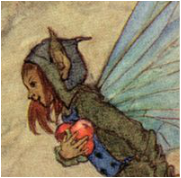 Florence Harrison was another artist who drew many fairies for fairytale books. In books such as the 1912 Elfin Song, her brownies, elves and banshees had quite large and pointed ears. They look very Rackham-esque. 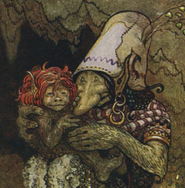 1912: Swedish magazine Among Gnomes and Trolls #6 - one of many illustrations by John Bauer shows a pair of trolls with long ears. However, a small fairy with long golden hair has her ears hidden. 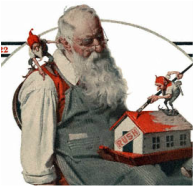 In 1922, Norman Rockwell drew Santa Claus surrounded by tiny, pointy-eared elves. 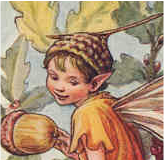 Flower Fairies of the Spring (1923) was the first of many books by by Cicely Mary Barker. Her fairies resemble Tinker Bell in that they are small and winged. They frequently have their ears covered by hair or hats. However, when their ears are exposed, as shown here in the Acorn Fairy picture from Flower Fairies of the Autumn, they are definitely small and pointed. Mopsa the Fairy (1869) by Jean Ingelow has fairies of varying sizes who start as tiny infants. There's no textual mention of their ears, which seem to be covered by their hair in the original illustrations. However, in a 1927 edition, Dorothy P. Lathrop's illustrations give the baby fairies large, pointed ears. 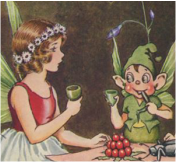 1933: A Bunch of Wild Flowers, by Ida Rental Outhwaite, has different varieties of fairies. Notice that again, the smaller, cartooned one has large ears, while the more realistic fairy has her ears covered by her hair. 1935: Goldie the elf in Disney’s “Midas” short has round ears. So pointy ears still aren't ubiquitous. 1937: Tolkien publishes The Hobbit. 1939: In illustrations for Enid Blyton's series The Faraway Tree series, the fairies are clearly point-eared. A brownie character is named Big Ears. 1953: Walt Disney produces Peter Pan and I think from this point you can just solidly say that fairies are going to be little and sparkly with wings and, most importantly, pointy ears. Especially because Tinker Bell quickly becomes a mascot for Disney. (The pointy ears were Disney's initiative even in Tink's case. In the original book Barrie makes no mention of them that I can find, and in the illustrations she is too small to tell what her ears look like.) 1954: Hi again, Tolkien. (By the time he's written the Fellowship of the Ring, he's actually moved farther away from fairies and folklore, and has created his own brand of elf. But that's a whole different subject.) In 1967, on the Star Trek episode "This Side of Paradise," Kirk tells Spock, "You're an overgrown jackrabbit, an elf with a hyperactive thyroid." In 1968, the Keebler Elves were created. And in 1977, in the novel The Sword of Shannara, elves have “strange pointed ears.” By this point, pointy ears have become typical attributes of elves and fairies. So why did this trait become popular? Pointed ears are a quick way of showing that a character is not entirely human. They’re also easy to draw or to create in costumes. Personally, I'd point to Disney's Tinker Bell as well as Rackham's illustrations and Barker's Flower Fairies as the ones who really popularized the modern idea of the fairy. The pointed ears lead back to brownies and hobgoblins like Puck, and through Puck to Greek satyrs. Ultimately, this trait is a way to show that a being is nonhuman - perhaps wild or monstrous like an animal, but always otherworldly. Sources and further reading
Text copyright © Writing in Margins, All Rights Reserved
1 Comment
Reply
Leave a Reply. |
About
Researching folktales and fairies, with a focus on common tale types. Archives
July 2024
Categories
All
|
Writing in Margins
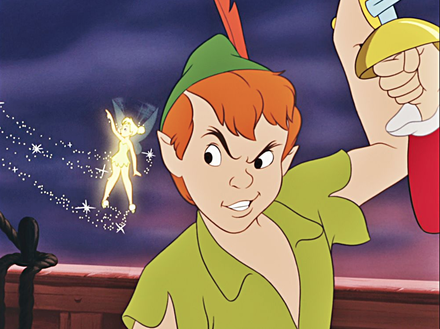
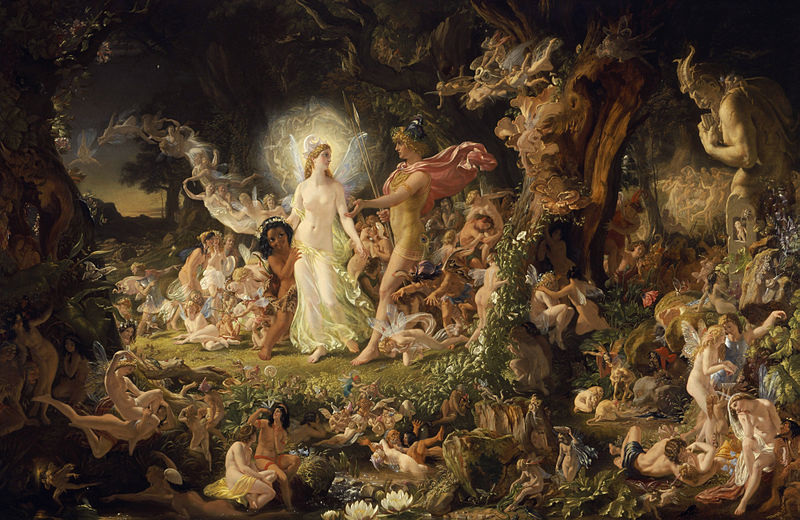
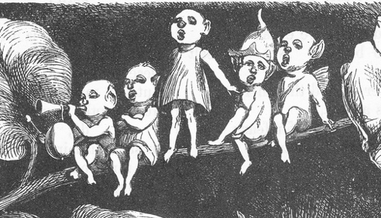
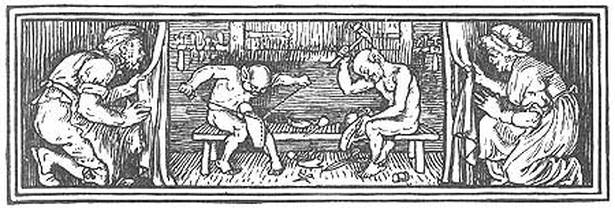
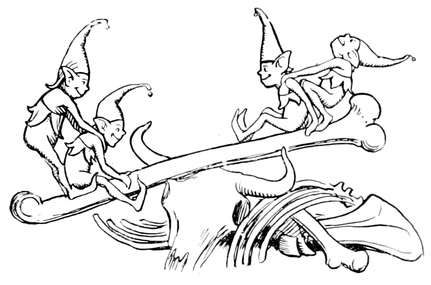
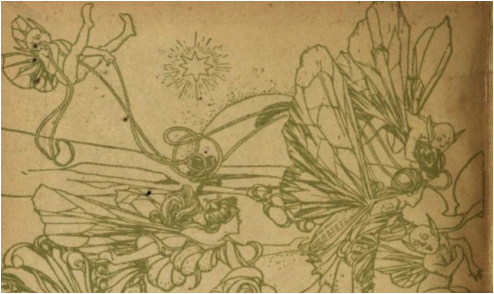
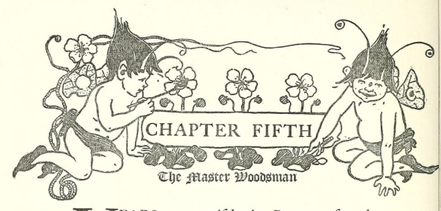
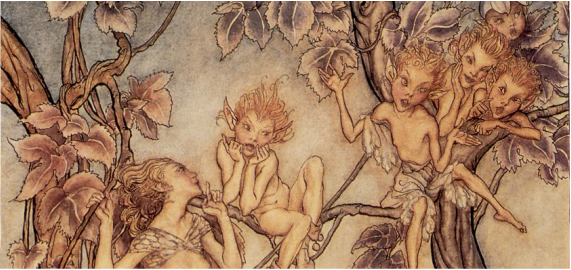
 RSS Feed
RSS Feed
